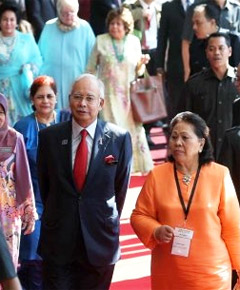fitness news
![]() ,
,![]()
Font size Women’s Health
Healthier girls and women can benefit economy: Malaysias prime minister
– Reported, June 13, 2013
 There has always been the ethical and humanitarian case for investing in girls and womens health. But the argument that such investment can yield significant economic benefits is now finding a dazzling array of takers.
There has always been the ethical and humanitarian case for investing in girls and womens health. But the argument that such investment can yield significant economic benefits is now finding a dazzling array of takers.
At Kuala Lumpur, before an august gathering of almost 5,000 people from 149 countries, Malaysias prime minister Najib Razak waxed eloquent about the need for public investment in education, health, safety, rights and financial independence of girls and women. Malaysia sees this as smart investment.
The evidence, from developed and developing nations alike, is clear. When our girls and women are educated, when they are healthy, when they are independent, the benefits extend beyond individual freedom to prosper and achieve, Razak noted in his keynote speech at the Third Women Deliver conference. The global meet focused on the critical need to prioritize girls and women in the run-up to the 2015 Millennium Development Goal (MDG) deadline, and beyond.
Malaysias national maternal mortality ratio (MMR) the number of women dying because of childbirth-related complications per 100,000 live births has come down from 540 in 1957 to just 28 in 2010. No doubt, Malaysia is blessed with natural resources, has less than 30 million people, and national statistics do not tell the full story. But the sharp decline in maternal deaths is undeniably an impressive achievement.
In the 1950s and 1960s, the state of health services in Malaysia was similar to many developing countries today. But Malaysia, like Thailand, Sri Lanka and many other countries, did not wait to get rich before investing in womens education, health and rural development. This is key to its dramatic reduction in maternal mortality.
In 1970, Malaysias MMR was down to 105 per 100,000 live births. In the decades that followed, health services were made available at the doorstep of rural populations, health workers were sensitized on social and cultural factors that affect womens health, midwives working in remote areas were given more support, hospitals waived fees for poor patients and a colour-coding system was designed to make it easier for women to be referred to a hospital, sidestepping bureaucratic red-tape. Well-being clinics were set up across the country to expand womens access to family planning.
All these initiatives have paid off. Now, Malaysia, one of the fastest growing market economies in the world, wants to tell its story before the international community. This is not just a Malaysian tale. Many countries across the developing world opted to invest in womens health and human development in general long before they became rich.
A new report (closing the deadly gap between what we know and what we do) by the World Bank which generated a huge buzz at the Kuala Lumpur meet makes the economic case for investments in womens reproductive health.
Womens health is more than an economic issue but framing access to healthcare facilities and family planning services as smart economics gives it the much-needed visibility in the policy discourse.
The World Bank argues that when women have better education, health and access to contraceptives, they have more power to take decisions within the household and they prioritize the well-being of their children. When children are better educated, they are potentially more productive as adults and contribute more to economic growth.
Globally, female labour force participation decreases with each additional child by about 10 to 15 percentage points among women in the 25-39 age-group and about 5 to 10 percentage points among women in the 40-49 age-group, the report notes.
CREDITS.
For more Malaysia news Click Here